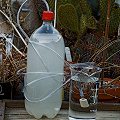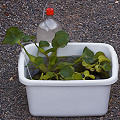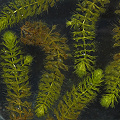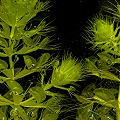Q: Aldrovanda: cultivation

Carbon dioxide
generator

Darnowski style

Aldrovanda

Branching
A: This can be either a very difficult plant to grow, or embarrassingly easy.
Reliable, cookbook planting instructions are quite complicated. Until recently, the only reliable method for growing
these plants required that you grew them with other bog plants, such as Typha minima (dwarf cattail),
Carex sp. (sedges), Phragmites australis (common reed), and
Menyanthes trifoliata (bog buckbean).
A very good summary of this knowledge is in my book, and also in the September 1997 issue of Carnivorous Plant Newsletter.
The complicated method of cultivation is the one that I have had the most success with.
I have grown the plants in a 200 liter (60 gallon) tank with other
plants like water lilies (Nymphaea), Sedges (Carex) etc.
The addition of Utricularia inflata was very helpful---when
nutrient levels would rise, the Utricularia grows quickly and sucks the nutrients
out of the water. Carbon dioxide generators (yeast and sugar water) supply carbon dioxide via rubber tubes. The bottom of
the tray had a substrate of peat, sand and leaf litter from Phragmites australis.
Doug Darnowski promotes an embarrassingly easy method, in which the plants are grown in a tub with a substrate of plain garden soil. The tub
is filled with water, and a few water hyacinth plants (Eichhornia crassipes) are added. It is the
horticulturist's responsibility to determine if it is
legal to have water hyacinth in their country, state, or province
(it is invasive and costly to eradicate or manage), and also to make sure it does not escape to
wildlands, where it can become a nasty invasive species. Doug thinks the water hyacinth may provide some aspect of water
conditioning (much as I observed from Utricularia inflata), and that their dangling roots
may also provide breeding grounds
for prey items such as Daphnia.
Provide winter temperatures that mimic the provenance of your plants.
I've worked a great deal with growing aquatic Utricularia, and I think that the addition
of leaf litter is critical to produce success with these plants. Similarly, I think it is very important
when growing Aldrovanda.
Propagation is by stem proliferation, which the plant does quite readily as long as you grow it well. It is hugely
difficult to coerce the little white flowers to produce seed. I've never even grown the plants well enough so that the flowers
matured---they always just abort before opening. Damn.
Never add creatures such as snails or other herbivorous critters to your Aldrovanda tank as they
might feast upon your desired plants. If you observe mosquito larvae, you can control them with Bt toxin with no harm
to the plants.
Page citations: Breckpot, C. 1997; Darnowski, D.W. 2002a; Degreef, J.D. 1997;
Rice, B.A. 2006a; Schlauer, J. 1997, 2002; personal observations.